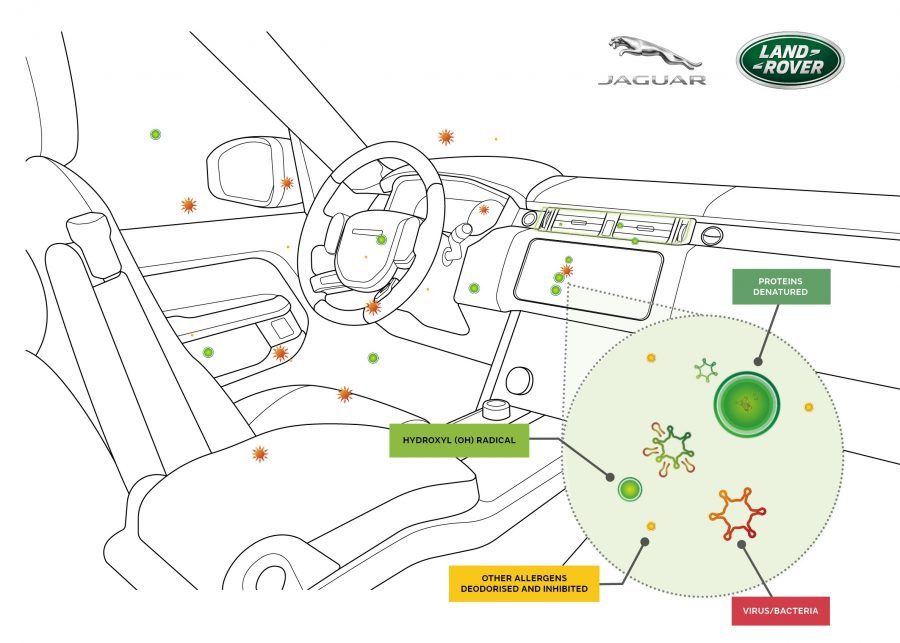 Panasonic confirms that Jaguar Land Rover*1, a luxury automobile brand will use Panasonic’s nanoe™ X technology in in-vehicle HVAC systems in the future. Models across the Jaguar range, including the new all-electric Jaguar I-PACE performance SUV, and Land Rover line-up – including the Discovery and Range Rover Evoque – currently offer nanoe™ technology.
Panasonic confirms that Jaguar Land Rover*1, a luxury automobile brand will use Panasonic’s nanoe™ X technology in in-vehicle HVAC systems in the future. Models across the Jaguar range, including the new all-electric Jaguar I-PACE performance SUV, and Land Rover line-up – including the Discovery and Range Rover Evoque – currently offer nanoe™ technology.
nanoe™ is a nanosized particulate ion produced by applying a high voltage to water in the air and contains hydroxyl radicals (highly reactive components) that easily act on various substances. The production of these hydroxyl radicals has been increased tenfold compared to conventional products, and nanoe™ X is used in home appliances such as air purifiers, air conditioners, washing machines, and refrigerators, as well as in automobiles, trains, and commercial air-conditioning equipment because of its various effects such as deodorization*2 inhibition of bacteria*3 and allergens*4
In the other automotive sector, Grab Holding Inc. the leading everyday super app in Southeast Asia collaborated with Panasonic to further raise GrabCar Premium standards by providing cleaner and more comfortable travelling experience for GrabCar Premium passengers using nanoe™ X.
Not only the automotive sector but Panasonic will continue to pursue the realization of “QUALITY AIR FOR LIFE” in various areas of our lives and society, including home appliances, automotive, and housing-related fields, to deliver a healthy lifestyle.
Notes:
*1 Jaguar Land Rover Automotive plc (“the Company”) and its subsidiaries are collectively referred to as “the Group” or “JLR”. The Company is a public limited company incorporated and domiciled in the United Kingdom. The address of its registered office is Abbey Road, Whitley, Coventry CV3 4LF, England, United Kingdom. The Company is a subsidiary of Tata Motors Limited, India and acts as an intermediate holding company for the Jaguar Land Rover business. The principal activity during the year was the design, development, manufacture and marketing of high-performance luxury saloons, specialist sports cars and four-wheel-drive off-road vehicles.
*2 The following effects have been verified after about 12 minutes in a space of approximately 23 m3. However, this is not the result of measurement in actual use space.
- Testing organisation: Product Analysis Center, Panasonic Corporation
- Test method: verified using the six-level odour intensity scale method in an approximately 23 m3 sized test room.
- Deodorising method: nanoe™ released
- Test substance: adhered cigarette smoke odour
- Test result: odour intensity reduced by 2.4 in 12 minutes (4AA33-160615-N04)
*3 The following effects have been verified after about 4 hours in a space of approximately 25 m3 (However, the results are not measured in actual use space)
- Testing organisation: Kitasato Research Center for Environmental Science
- Test method:the number of bacteria is measured after direct exposure in an approximately 25 m3 sized airtight test room
- Inhibition method: nanoe™ released
- Test substance: airborne bacteria
- Types of bacteria tested: 1 type
- Test result: 99% or more inhibition in 4 hours (24_0301_1)
*4 The following effects have been verified after about 24 hours in a space of approximately 23 m3. (However, this is not the result of measurement in an actual use space.
- Testing organisation: Panasonic Product Analysis Center
- Testing method: Verified using the electrophoresis method in an approximately 23m3 sized test room
- Inhibition method: nanoe™ released
- Test substance: allergens
- Test result: 99% or more inhibition in 24 hours (4AA33-151001-F01)
About Panasonic
Panasonic Corporation is a worldwide leader in the development of diverse electronics technologies and solutions for customers in the consumer electronics, housing, automotive, and B2B businesses. The company, which celebrated its 100th anniversary in 2018, has expanded globally and now operates 528 subsidiaries and 72 associated companies worldwide, recording consolidated net sales of 7.49 trillion yen for the year ended March 31, 2020. Committed to pursuing new value through innovation across divisional lines, the company uses its technologies to create a better life and a better world for its customers. To learn more about Panasonic: https://www.panasonic.com/global.
